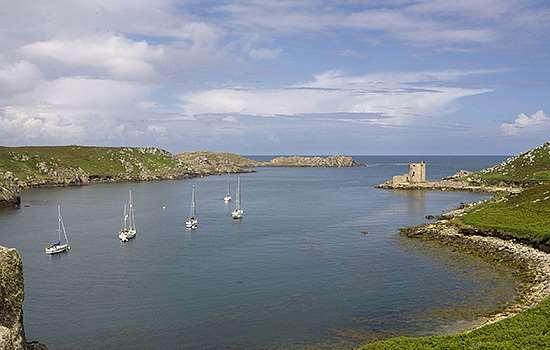History of Cromwell’s Castle
This tall round tower, standing on a low projecting shelf of rock on Tresco in the Isles of Scilly, is one of only a few stone fortifications that survive from the Interregnum (1649–60). It takes its name from Oliver Cromwell, Lord Protector of England.

The fort replaced a Tudor blockhouse on the site, and superseded King Charles’s Castle, which had been built in the 1550s on higher ground but proved to be poorly sited. It was partly demolished to provide building stone for this later castle.
Royalists had held out on the Isles of Scilly for most of the Civil War period. Increasing tension with the Dutch, and in particular the arrival of a Dutch fleet off the islands in March 1651 demanding reparations from the Royalist privateers based there, prompted Parliament to send Robert Blake, the most successful admiral of the 17th century, to recapture these strategic islands.
The castle was built in 1651, following swiftly on Blake’s success, to guard one of the main routes of entry to the heart of the islands and the deep water approach to New Grimsby harbour. It faced a potential enemy with an impossible choice.
No fleet could hope to land troops on this side of Tresco unless it had first destroyed or captured the castle, but the chances of destroying the castle by gunfire from the sea were very slim. The fort was considered worth updating a century later, when a platform for cannon was added on the seaward side.
Description
The castle consisted of a basement, two upper storeys and a gun platform on the roof. The rubble walls below the platform are almost 13 feet (4 metres) thick; internally the tower measures nearly 20 feet (6 metres) across and is over 50 feet (15 metres) high. The original entrance, later blocked, was high up on the south side, reached by external wooden stairs. Stone supports or corbels, projecting out from the doorway, would have supported a wooden platform in front of it.
The roof survives, supported by a fine ribbed vault, and although the intervening floors have gone, their positions are evident from joist holes and fireplaces. The basement was presumably intended for storage. A spiral staircase within the walls takes the visitor up to the roof, where the six widely splayed gunports give an all-round field of fire.
On the south-west side of the tower, facing the sea, is the large 18th-century gun platform that replaced the original gun battery. The gun platform, designed for six cannon, is surrounded by a low parapet wall.
To provide better access to the tower the original entrance was made into a window and a new one made from the platform. The rooms on either side of the later entrance – a guardroom with a fireplace to the right, and a latrine to the left – are also 18th-century additions.
Further Reading
The Garrison, St Mary’s Isles of Scilly: A Walk Around the Walls (Bristol: English Heritage)
Bowley, RL, Scilly at War (St Mary’s, 2001)
Miles, TJ and Saunders, AD, ‘King Charles’s Castle, Tresco, Scilly’, Post-Medieval Archaeology, 4 (1971), 1–30
Morley, B, Henry VIII and the Development of Coastal Defence (London, 1976)
Saunders, AD, ‘Harry’s Walls, St Mary’s, Scilly: a new interpretation’, Cornish Archaeology, 1 (1962), 85–91
Spreadbury, ID, Castles in Cornwall and the Isles of Scilly (Redruth, 1984)
Tolhurst, M, The English Civil War (London, 1992)



